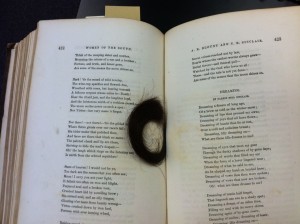By: Amy Chen, CLIR Postdoctoral Fellow
In September 2014, Wade Hall’s Library, an exhibition of Wade Hall’s extensive collection of books — a large portion are dedicated to Southern Literature — will be mounted in the Pearce Lobby of the Amelia Gayle Gorgas Library. Occasionally, we will be promoting this exhibition by showcasing a few of the items that will be on display. Today, we examine one of the most interesting aspects of book collecting, which is occasionally finding the items tucked into books by their previous owners.
Mary Forrest. Women of the South Distinguished in Literature. Illustrated with Portraits on Steel. New York, NY: Charles B. Richardson, 1866. Second Edition.
This anthology of Southern women’s writing is remarkable for both its year of publication and its interest area: Women of the South Distinguished in Literature is not only the first anthology dedicated to Southern writing, but also the first to document women’s writing.[1] Significant authors collected in this anthology include Caroline Lee Hentz, Sally Rochester Ford, and Augusta Jane Evans Wilson. Wilson became particularly famous as Alabama’s first professional author; she was later inducted Alabama Women’s Hall of Fame. Also worth noting are the four women who are grouped together as “writers not yet authors”: Jane T. Worthington, R. Jacobus, Bessie B. Cheesborough, and Emelie C.S. Chilton. These “writers” are represented by only one or two pieces, whereas the volume’s “authors” have between four and fourteen pieces included. Helpfully, each entrant in the anthology also is given a brief biographical sketch.
Women of the South Distinguished in Literature was first published prior to the Civil War; this second edition features two ownership signatures inside the front cover and two written in the back. All four are written in pencil by Miss Josie MacDonald, who became Mrs. John Hart. MacDonald clearly treasured the volume: she tucked her calling card into the book and wrote her address on the book, which allows contemporary researchers to learn that she lived in an elegant row house on 1936 Jefferson St. Louisville, Kentucky, which was built in 1900 and is still standing.
Also of interest are a number of items Mrs. John Hart slipped into the pages of the volume. The first item that can be seen is a form from postmaster John Barrett addressed to the occupant of 1936. The postmaster requests the names of all residents of the home and notes that women should have their first name represented, not just the name of their husband. An article, likely from the local Louisville, Kentucky newspaper titled “Augusta Evans Wilson: A Venerated Novelist” can also be located. The article does not have a date or author indicated, but it discusses “the truth about the origin of the name ‘St. Elmo,’” which is the title of one of Evans’s books.
Additionally, a brown ringlet of hair can be found within the selection of Carrie Bell Sinclair’s poetry. While hair seems to be an odd item to come across in a book, those from the turn of the century treasured it; hair was often made into jewelry or wreaths, kept to make into hairpieces, or exchanged by friends and lovers as a memento. The hair as well as all the other items in the book is in good condition. However, the book itself is only in fair condition, as the front cover has become detached from the spine.
[1] Susan H. Irons, “Anthologies of Southern Literature,” The Companion to Southern Literature: Themes, Genres, Places, People, Edited by Joseph M. Flora, Lucinda Hardwick MacKethan, and Todd W. Taylor (Baton Rouge, LA: Louisiana State University Press, 2002), 35.

